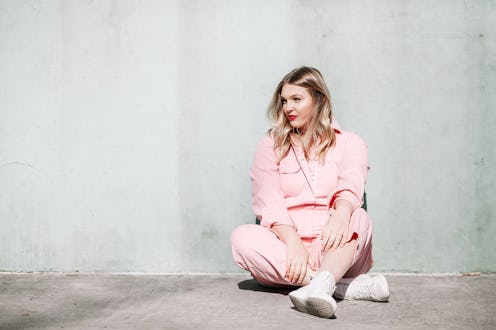Fashion
Bustle's 'The Fitting Room' Shares People's Thoughts About Sizing & Shopping
When I think of a fitting room, nothing positive comes to mind. There are memories of me tearing off things in harsh lighting, sweating profusely because, "God, why is there not more air conditioning in these things?" There are flashbacks of sheer panic washing over my body when I tried on too-tight clothes while shopping alone and simply could not get them of my body. There are more than a few scenes of me walking out of a fitting room and choking back tears, because why does finding something that fits and feels good have to be so damn hard? I've been 6 feet tall all my life and, having been both straight size and plus size, one main thing has rung true through my entire existence: Fitting rooms kind of suck — for me, and for most people with a body.
The nuances of finding clothing that fits your body in an industry with sizing that is inconsistent and almost always more exclusive than inclusive are virtually endless. And the further your body gets from the "average" size, the more complicated things become. In an effort to hear about real people's tips, tricks, frustrations, and hopes for sizing, shopping, and the intersection of the two, Bustle surveyed more than 400 people of many body types about everything from how clothing fits them to where they have the best luck when shopping.
The results of the survey, though varied, were an important reminder that the frustrations we all sometimes feel in fitting rooms or shopping online are universal in more ways than they are not, and that the problem with finding clothing that fits is never with us or our bodies, but with the system itself.
Yes, the general survey results revealed that shopping is frustrating for everyone — but if you have a body that is doesn't fit into fashions very narrow mold of what is "easiest" to dress, then things are even more complicated. While the survey allowed people to identify their body type in any way that made the most sense to them, the survey also resulted in a particularly large amount of participants in four specific categories — plus size, petite, tall, and petite plus size.
In addition to the above stories about clothing sizes, the survey also resulted in two stories about people who have a shoe size under a size 5.5 and a size 10 shoe or over.
What all of these stories have in common is an idea that we explored further in a piece about how utterly frustrating online size calculators can be. This idea is the same idea that is at the heart of The Fitting Room: Human bodies are endlessly varied and always attached to an actual human — one with feelings, insecurities, and emotional nuances. Human bodies can never be fully explained by just an algorithm or a set of measurements that are supposed to help you find your size.
The industry, and sizing in particular, is often broken down into averages. Average weights, average heights, average sizes. How often have you heard about the almighty "size of the average American woman", after all? Phrases like this are thrown around lightly, often as examples to support the idea that if the average size is a 14, there should be more plus sizes available. This is all true, of course. More inclusive sizing is something that's necessary. But human bodies are not averages or average at all, really. They are wholly unique. Even with the most similar measurements, they are never, ever the same.
But these inherent differences shouldn't mean that we simply give up when it comes to providing clothing that fits for everyone, or creating tools that help people find their size. They mean that we should always be asking more of the industry. We should always be looking at what's available, seeing the gaps, and asking for more. We should always be asking for clothing that fits not only our bodies, but other marginalized bodies, too.
Because of this, Bustle will now note the available size range from a brand in any article in which a clothing brand is mentioned — whether the story focuses on sizing or not. This initiative will serve as an important note to readers about whether or not a brand offers options for them, but also hopefully as an impetus to brands to strive to offer more. Because, as The Fitting Room survey showed us, as long as bodies are as unique as the human's attached to them, there is always a need for more. And in a system that is often designed to make us feel like the problem with sizing and shopping is with our bodies, it's important to remember that the problem is never with us.
